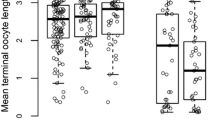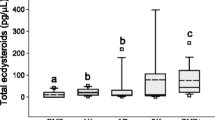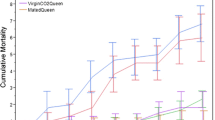Abstract
Possible pheromonal control of worker reproduction was tested in Bombus terrestris. The mode of assay included exposure of callow workers to extracts originating from different queen parts and measuring the effect on the in vitro biosynthesis of juvenile hormone (JH), the apparent gonadotropin in this species. Both queen total body extracts applied to dummies consisting of oven-dried or Soxhlet-washed virgin queen bodies and cuticular washes applied to living virgin queens effectively inhibited the biosynthesis of JH in callow workers. None of the five exocrine glands (mandibular, hypopharyngeal, salivary, Dufour's, and tarsal) demonstrated inhibitory activity. Likewise, the use of synthetic 3-hydroxy acids, found in queen mandibular glands, were ineffective in blocking JH biosynthesis in queenless workers. The results suggest that the queen may use a primer pheromone spread on the epicuticle as a means to inhibit worker reproduction. However, our results are not consistent with the prevailing hypothesis that in B. terrestris the main source of the pheromone that inhibits worker reproduction is in the queen's mandibular glands.
Similar content being viewed by others
REFERENCES
Arnold, G., Le Conte, Y., Trouiller, J., Hervet, H., Chappe, B., and Masson, C. 1994. Inhibition of worker honeybee ovaries development by a mixture of fatty acid esters from larvae. C.R. Acad. Sci. (III) 317:511–515.
Blight, E. G., and Dyer, W. J. 1959. A rapid chemical method of total lipid extraction and purification. Can. J. Biochem. Physiol. 37:911–917.
Bloch, G., Borst, D. W., Robinson, G. E., Huang, Z. Y., and Hefetz, A. 1996. Effects of social conditions on Juvenile Hormone mediated reproductive development in Bombus terrestris workers. Physiol. Entomol. 21:257–267.
Blum, M. S., and Brand, J. 1972. Social insects pheromones: Their chemistry and function. Am. Zool. 12:553–576.
Butler, C. G. 1959. The source of the substance produced by a queen honeybee (Apis mellifera) which inhibits development of the ovaries of the workers of her colony. Proc. R. Entomol. Soc. London. 34:137–138.
Butler, C. G., Callow, R. K., and Johnston, N. C. 1961. The isolation and synthesis of queen substance, 9-oxodec-trans-2-enoic acid, a honeybee pheromone. Proc. R. Entomol. Soc. London. (B) 155:417–432.
Currie, R. W., Winston, M. L., and Slessor, K. N. 1994. The effect of honey bee (Apis mellifera L) synthetic queen mandibular compound on queenless disposable pollination units. Am. Bee J. 134:200–202.
Dale, J. F., and Tobe, S. S. 1986. Biosynthesis and titre of Juvenile hormone during the first gonotrophic cycle in isolated and crowded Locusta migratoria females. J. Insect Physiol. 32:763–769.
Doorn, A. Van. 1987. Investigations into the regulation of dominance behaviour and of the division of labour in bumblebee colonies (Bombus terrestris). Neth. J. Zool. 37:255–276.
Doorn, A. Van., and Chrambach, A. 1989. Retinue behaviour in bumblebee workers (Bombus terrestris L.). J. Apic. Res. 28:66–70.
Doorn, A. Van., and Heringa, J. 1986. The ontogeny of a dominance hierarchy in colonies of the bumble bee Bombus terrestris (Hymenoptera: Apidae). Insectes Soc. 33:3–25.
Duchateau, M. J. 1989. Agonistic behaviours in colonies of the bumblebee Bombus terrestris. J. Ethol. 7:141–151.
Duchateau, M. J., and Velthuis, H. H. W. 1988. Development and reproductive strategies in Bombus terrestris colonies. Behaviour 107:186–207.
Duchateau, M. J., and Velthuis, H. H. W., 1989. Ovarian development and egg laying in workers of Bombus terrestris. Entomol. Exp. Appl. 51:199–213.
Dulka, J. G., Stacey, N. E., Sorensen, P. W., and van der Kraak, G. J. 1987. A steroid sex pheromone synchronizes male-female spawning readiness in goldfish. Nature 325:251–253.
Feyereisen, R. 1985. Regulation of juvenile hormone titer: synthesis, pp. 391–429, in G. A. Kerkut, L. I. Gilbert (eds.). Comprehensive Insect Physiology, Biochemistry and Pharmacology. Pergamon Press, Oxford.
Feyereisen, R., and Tobe, S. S. 1981. A rapid partition assay for routine analysis of juvenile hormone release by insect corpora allata. Anal. Biochem. 111:372–375.
Fletcher, D. J. C., and Ross, K. G. 1985. Regulation of reproduction in eusocial Hymenoptera. Annu. Rev. Entomol. 30:319–343.
Free, J. B. 1987. Pheromones of Social Bees. Chapman and Hall, London.
Gilby, A. R. 1980. Chemical methods (lipids), pp. 217–253, in T. A. Miller (ed.). Cuticular Techniques in Arthropods. Springer-Wallas, New York.
Hefetz, A., Taghizadeh, T., and Francke, W. 1996. The exocrinology of the queen bumble bee Bombus terrestris (Hymenoptera: Apidae, Bombini). Z. Naturforsch. 51:409–422.
HÖlldobler, B., and Bartz, ST. H. 1985. Sociobiology of reproduction in ants, pp. 237–258, in B. Hölldobler and M. Lindauer (eds.). Experimental Behavioral Ecology and Sociobiology. Sinauer Associates, Sunderland, Massachusetts.
HÖlldobler, B., and Wilson, E. O. 1990. The Ants. Belknap Press, Cambridge, Massachusetts.
Honk, C. G. J. Van, Velthuis, H. H. W., RÖseler, P. F., and Malotaux, M. E. 1980. The mandibular glands of Bombus terrestris queens as a source of queens pheromones. Entomol. Exp. Appl. 28:191–198.
Huang, Z. Y., Robinson, G. E., Tobe, S. S., Yagi, K. J., Strambi, C., Strambi, A., and Stay, B. 1991. Hormonal regulation of behavioural development in the honey bee is based on changes in the rate of juvenile hormone biosynthesis. J. Insect Physiol. 37:733–742.
Kaatz, H. H., Hilderbrant, H., and Engels, W. 1992. Primer effect of queen pheromone on juvenile hormone biosynthesis in adult honey bees. J. Comp. Physiol. B 162:588–592.
Keller, L., and Nonacs, P. 1993. The role of queen pheromones in social insects: Queen control or queen signal? Anim. Behav. 45:787–794.
Lanzrein, B., Gentinetta, V., Fehr, R., and Luscher, M. 1978. Correlation between haemolymph juvenile hormone titre, corpus allatum volume and corpus allatum in vivo and in vitro activity during oocyte maturation in a cockroach (Nauphoeta cinerea). Gen. Comp. Endocrinol. 36:339–345.
Larrere, M., and Couillaud, F. 1993. Role of juvenile hormone biosynthesis in dominance status and reproduction of the bumblebee, Bombus terrestris. Behav. Ecol. Sociobiol. 33:335–338.
Michener, C. D. 1974. The Social Behavior of the Bees. Belknap Press, Cambridge, Massachusetts.
Pettis, J. S., Winston, M. L., and Collins, A. M. 1995. Suppression of queen rearing in European and Africanized honey bees Apis mellifera L. by synthetic queen mandibular gland pheromone. Insectes Soc. 42:113–121.
Plowwright, R. C., and Laverty, T. M. 1984. The ecology and sociobiology of bumblebee. Annu. Rev. Entomol. 29:175–199.
Pomeroy, N., and Plowright, R. C. 1982. The relation between worker numbers and the production of males and queens in the bumble bee Bombus perplexus. Can. J. Zool. 60:954–957.
Pratt, G. E., and Tobe, S. S. 1974. Juvenile hormone radiobiosynthesised by corpora allata of adult female locusts in vitro. Life. Sci. 14:575–586.
RÖseler, P. F., 1977. Juvenile hormone control of oogenesis in bumblebee workers, Bombus terrestris. J. Insect. Physiol. 23:985–992.
RÖseler, P. F., and RÖseler, I. 1978. Studies on the regulation of the juvenile hormone titre in bumblebee workers, Bombus terrestris. J. Insect. Physiol. 24:707–713.
RÖseler, P. F., and Honk, C. G. J. van. 1990. Castes and reproduction in Bumblebees, pp. 147–166, in W. Engels (ed.). Social Insects, An Evolutionary Approach to Castes and Reproduction. Springer-Verlag, Berlin.
RÖseler, P. F., RÖseler, I., and Honk, C. G. J. van. 1981. Evidence for inhibition of corpora allata activity in workers of Bombus terrestris by a pheromone from the queen's mandibular glands. Experientia 37:348–351.
Slessor, K. N., Kaminski, L. A., King, G. G. S., Borden, J. H., and Winston, M. L. 1988. Semiochemical basis of the retinue response to queen honey bees. Nature 332:354–356.
Slessor, K. N., Foster, L. G., and Winston, M. L. 1998. Royal flavors: Honey bee queen pheromones, pp. 314–330, in R. K. Vander Meer, M. D. Breed, M. L. Winston, and K. E. Espelie (eds.). Pheromone Communication in Social Insects: Ants, Wasps, Bees and Termites. Westview Press, Boulder, Colorado.
Spradbery, J. P. 1991. Evolution of queen number and queen control, pp. 336–388, in K. G. Ross and R. W. Matthews (eds.). The Social Biology of Wasps. Cornell University Press, Ithaca, New York.
Tobe, S. S., and Pratt, G. E. 1974. The influence of substrate concentrations on the rate of insect juvenile hormone biosynthesis by corpora-allata of the desert locust in vitro. Biochem. J. 144:107–113.
Wheeler, J. W., and Duffield, R. M. 1988. Pheromones of Hymenoptera and Isoptera, pp. 59–206, in E. D. Morgan and N. B. Mandava (eds.). CRC Handbook of Natural Pesticides. IV: Pheromones. CRC Press, Boca Raton, Florida.
Willis, L. G., Winston, M. L., and Slessor, K. N. 1990. Queen honey bee mandibular pheromone does not effect ovary development. Can. Entomol. 122:1093–1099.
Wilson, E. O. 1971. The Insect Societies. Belknap Press, Cambridge, Massachusetts.
Winston, M. L., Higo, H. A., Colley, S. J., Pankiw, T., and Slessor, K. N. 1991. The role of queen mandibular pheromone and colony congestion in honey bee (Apis mellifera L.) reproductive swarming (Hymenoptera: Apidae). J. Insect Behav. 4:649–660.
Author information
Authors and Affiliations
Rights and permissions
About this article
Cite this article
Bloch, G., Hefetz, A. Reevaluation of the Role of Mandibular Glands in Regulation of Reproduction in Bumblebee Colonies. J Chem Ecol 25, 881–896 (1999). https://doi.org/10.1023/A:1020805103379
Issue Date:
DOI: https://doi.org/10.1023/A:1020805103379




